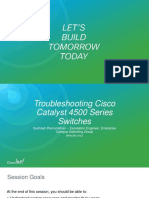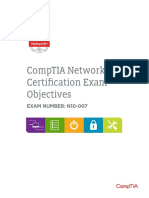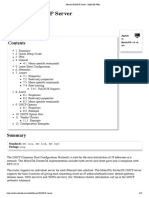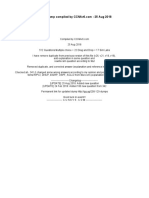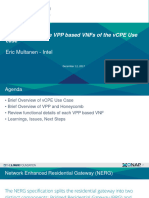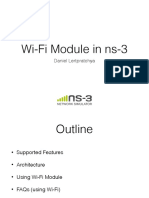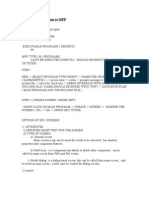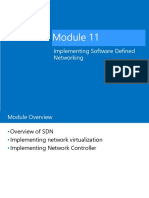0 ratings0% found this document useful (0 votes)
207 viewsMtctce PDF
Mtctce PDF
Uploaded by
Álvaro DuránThis document outlines the topics covered in the MikroTik Certified Traffic Control Engineer certification. The certification covers:
1. Packet flow diagrams and examples of how packets travel through routing, bridging, and connections to routers.
2. Firewall configuration including connection tracking, filter rules, NAT, and mangle rules.
3. QoS configuration including HTB, burst, queue types like FIFO and SFQ, and simple queue configuration.
Copyright:
© All Rights Reserved
Available Formats
Download as PDF, TXT or read online from Scribd
Mtctce PDF
Mtctce PDF
Uploaded by
Álvaro Durán0 ratings0% found this document useful (0 votes)
207 views1 pageThis document outlines the topics covered in the MikroTik Certified Traffic Control Engineer certification. The certification covers:
1. Packet flow diagrams and examples of how packets travel through routing, bridging, and connections to routers.
2. Firewall configuration including connection tracking, filter rules, NAT, and mangle rules.
3. QoS configuration including HTB, burst, queue types like FIFO and SFQ, and simple queue configuration.
Original Title
254473409-MTCTCE.pdf
Copyright
© © All Rights Reserved
Available Formats
PDF, TXT or read online from Scribd
Share this document
Did you find this document useful?
Is this content inappropriate?
This document outlines the topics covered in the MikroTik Certified Traffic Control Engineer certification. The certification covers:
1. Packet flow diagrams and examples of how packets travel through routing, bridging, and connections to routers.
2. Firewall configuration including connection tracking, filter rules, NAT, and mangle rules.
3. QoS configuration including HTB, burst, queue types like FIFO and SFQ, and simple queue configuration.
Copyright:
© All Rights Reserved
Available Formats
Download as PDF, TXT or read online from Scribd
Download as pdf or txt
0 ratings0% found this document useful (0 votes)
207 views1 pageMtctce PDF
Mtctce PDF
Uploaded by
Álvaro DuránThis document outlines the topics covered in the MikroTik Certified Traffic Control Engineer certification. The certification covers:
1. Packet flow diagrams and examples of how packets travel through routing, bridging, and connections to routers.
2. Firewall configuration including connection tracking, filter rules, NAT, and mangle rules.
3. QoS configuration including HTB, burst, queue types like FIFO and SFQ, and simple queue configuration.
Copyright:
© All Rights Reserved
Available Formats
Download as PDF, TXT or read online from Scribd
Download as pdf or txt
You are on page 1of 1
MTCTCE
MikroTik Certified Traffic Control Engineer
1) Packet flow diagram 4) DNS client/cache
1a) Why this diagram is necessary? 4a) Basic configuration
1b) full overview of all things covered by diagram 4b) Static DNS Entry
1c) simple examples how packet travels
throughout diagram (routing, bridging, connection
to router etc.) 5) DHCP client/relay/server
1d) more complex examples of diagram usage 5a) DHCP communication analysis
5b) DHCP-client identification/ configuration
5c) DHCP server configuration:
2) Firewall filter/nat/mangle - DHCP networks
- DHCP options (build-in and custom)
2a) Connection tracking - IP Pool
2b) Filter - advanced DHCP
- chains (default/custom) 5d) DHCP relay configuration
- all rule "actions" covered
- most common rule "conditions" covered
2c) NAT 6) web proxy
- chains (default/custom) 6a) basic configuration
- all rule "actions" covered 6b) proxy rule lists (Access\Direct Access\Cache)
- most common rule "conditions" covered 6c) most common proxy rules
- NAT helpers 6d) regular expression
2d) Mangle
- chains (default/custom)
- all rule "actions" covered
- most common rule "conditions" covered
2e) Some complicated rule "conditions" covered
("advanced", "extra" tab)
2f) uPNP
3) QoS
3a) HTB
- HTB general information
- HTB structure
- HTB Dual Limitation
- HTB priority
- HTB implementation in RouterOS (queue tree)
3b) Burst
3c) Queue types
- FIFO
- SFQ
- RED
- PCQ (more attention to this one)
- queue size
3d) Simple queue
Solution Box – Centro oficial de certificación Mikrotik
You might also like
- NextJS EbookDocument136 pagesNextJS Ebookalexmason0197100% (1)
- EDMCS Admin GuideDocument767 pagesEDMCS Admin GuideSunetra MoitraNo ratings yet
- BRKCRS 3142Document92 pagesBRKCRS 3142Daniel VieceliNo ratings yet
- Mtctce: Mikrotik Certified Traffic Control EngineerDocument1 pageMtctce: Mikrotik Certified Traffic Control EngineerKatsanaArunratNo ratings yet
- Micro Mobility and Ad Hoc Routing ProtocolsDocument65 pagesMicro Mobility and Ad Hoc Routing ProtocolsArul JothiNo ratings yet
- Fortigate NotesDocument2 pagesFortigate NotesVarisai Maideen Beevi JNo ratings yet
- CactiDocument33 pagesCactiabc123No ratings yet
- 300 410 ENARSI v1.1Document2 pages300 410 ENARSI v1.1naveen.anjeri100% (1)
- CCNA Exam v1.0 (200-301)Document5 pagesCCNA Exam v1.0 (200-301)Hitchiner HitchinerNo ratings yet
- 200 301 CCNA v1.1Document4 pages200 301 CCNA v1.1Aung KhaingNo ratings yet
- 300410enarsiDocument2 pages300410enarsiravi_nakarmi20019650No ratings yet
- Chapter4 IP ServicesDocument12 pagesChapter4 IP ServicesBara' AlqamNo ratings yet
- Cisco ISE BootCamp Powered by ColocviumDocument8 pagesCisco ISE BootCamp Powered by ColocviumstiteufNo ratings yet
- Network N10 007 Exam ObjectivesDocument19 pagesNetwork N10 007 Exam Objectivessalah_elgazzarNo ratings yet
- Implementing Cisco Enterprise Advanced Routing and Services v1.0 (300-410)Document3 pagesImplementing Cisco Enterprise Advanced Routing and Services v1.0 (300-410)Radhika SNo ratings yet
- Comptia N+ ObjectivesDocument19 pagesComptia N+ ObjectivesJohnnyNo ratings yet
- 200 301 CcnaDocument4 pages200 301 Ccnawilly c100% (3)
- Materi Olimpiade Jaringan MikroTik - APJIIDocument1 pageMateri Olimpiade Jaringan MikroTik - APJIISuyatno Pct100% (1)
- cisco-ICND1 CCNA GuideDocument35 pagescisco-ICND1 CCNA GuideHiếu Phan NgọcNo ratings yet
- CCNA Exam v1.0 (200-301)Document4 pagesCCNA Exam v1.0 (200-301)KhuongNo ratings yet
- CCNA 200-301 SyllabusDocument6 pagesCCNA 200-301 SyllabusArjun SenNo ratings yet
- 200 301 CCNA v1.0Document4 pages200 301 CCNA v1.0The Muslim LadyNo ratings yet
- n10 005 PDFDocument704 pagesn10 005 PDFPazNo ratings yet
- Comptia Network n10 007 V 3 0 Exam ObjectivesDocument19 pagesComptia Network n10 007 V 3 0 Exam ObjectivesnhNo ratings yet
- Comptia Network n10 007 V 3 0 Exam Objectives PDFDocument19 pagesComptia Network n10 007 V 3 0 Exam Objectives PDFAnonymous aihW5RTSP8No ratings yet
- CCNA NEW SyllabusDocument7 pagesCCNA NEW Syllabuskarthik coder0% (1)
- MTCNA Outline 1Document5 pagesMTCNA Outline 1กัมปนาท สุขสงวนNo ratings yet
- Manual - IP - DHCP Server - MikroTik WikiDocument15 pagesManual - IP - DHCP Server - MikroTik Wikimona_mi8202No ratings yet
- MTCNA OutlineDocument5 pagesMTCNA Outlinefajar rochmanNo ratings yet
- Mtctce OutlineDocument2 pagesMtctce OutlineyogaarsaNo ratings yet
- Datasheet: Thinking of Linking !Document7 pagesDatasheet: Thinking of Linking !jaeik changNo ratings yet
- 25-8-2018 CCNA 200 125 551Q CCNAv6 PDFDocument250 pages25-8-2018 CCNA 200 125 551Q CCNAv6 PDFiliutzaNo ratings yet
- dNAxt CCNA+NGFW Firewall+AWSDocument6 pagesdNAxt CCNA+NGFW Firewall+AWSnaveen.anjeriNo ratings yet
- CCNA Exam v12Document4 pagesCCNA Exam v12Daniel OteroNo ratings yet
- 3-Days Free Ccna WebinarDocument4 pages3-Days Free Ccna WebinarAtif KhanNo ratings yet
- SSE-F3548S - Supermicro Layer 3 Ethernet Networking SwitchDocument4 pagesSSE-F3548S - Supermicro Layer 3 Ethernet Networking SwitchValentin AtanassovNo ratings yet
- Huawei AC650-128AP Wireless Access Controller DatasheetDocument15 pagesHuawei AC650-128AP Wireless Access Controller DatasheetMoez KlaifiNo ratings yet
- CCNP Training - 20190108 - 202139391Document8 pagesCCNP Training - 20190108 - 202139391VishnuPriyaNo ratings yet
- CMU-CS-252-Laboratory-courses-and-tutorialsDocument5 pagesCMU-CS-252-Laboratory-courses-and-tutorialsphamthongqh12No ratings yet
- NimDocument4 pagesNimThis is ആനത്തലവട്ടംNo ratings yet
- Ceragon - IP10G - 4 Days Agenda - v3.1Document5 pagesCeragon - IP10G - 4 Days Agenda - v3.1Fredy benitesNo ratings yet
- Pages From AIC Items SpecificationsDocument11 pagesPages From AIC Items SpecificationsYonasNo ratings yet
- Traditional Routing: Software-Defined NetworkingDocument17 pagesTraditional Routing: Software-Defined NetworkingChang YeNo ratings yet
- Cisco Certified Network Associate Front PageDocument5 pagesCisco Certified Network Associate Front Pagehassanabid15No ratings yet
- vCPE VPP VNF Deep DiveDocument15 pagesvCPE VPP VNF Deep Divest.andrews.eveNo ratings yet
- Roup Of: Extension Compatible 24Document7 pagesRoup Of: Extension Compatible 244119 RAHUL SNo ratings yet
- Ns 3 Training Session 5Document54 pagesNs 3 Training Session 5sabitriNo ratings yet
- Computer NetworkDocument3 pagesComputer NetworkNeela RaiNo ratings yet
- Assignment 2Document4 pagesAssignment 2MohammadNaseerBatlaNo ratings yet
- Latest Dump Compiled by Genius PDFDocument127 pagesLatest Dump Compiled by Genius PDFMateus Gerboni100% (1)
- Readme enDocument45 pagesReadme enFire FighterNo ratings yet
- Network Administration For The Solaris 10 Operating System: Course DescriptionDocument2 pagesNetwork Administration For The Solaris 10 Operating System: Course DescriptionGaafar Mohammed GaafarNo ratings yet
- Rencana Pembelajaran TKJ Kelas X, Xi, XiiDocument5 pagesRencana Pembelajaran TKJ Kelas X, Xi, XiiAhmad RenaldaNo ratings yet
- ObjectGrouping Lecture4Document24 pagesObjectGrouping Lecture4Bhunesh KumarNo ratings yet
- Oracle - Problems With DPDK From A User Perspective (2016)Document19 pagesOracle - Problems With DPDK From A User Perspective (2016)prashrockNo ratings yet
- CompTIA Network Plus Training Kit Exam N10-005Document704 pagesCompTIA Network Plus Training Kit Exam N10-005bibivee67% (3)
- CheckPoint Firewall ConfigurationsDocument9 pagesCheckPoint Firewall ConfigurationsTuhin Kanti RoyNo ratings yet
- 1.IOS XR - Intro-UseDocument68 pages1.IOS XR - Intro-Useagus kurniawanNo ratings yet
- Internet Security: Cryptographic Principles, Algorithms and ProtocolsFrom EverandInternet Security: Cryptographic Principles, Algorithms and ProtocolsNo ratings yet
- Course Overview PostgreSQLDocument3 pagesCourse Overview PostgreSQLVadivel RajavelNo ratings yet
- Chapter 2 - ICTDocument12 pagesChapter 2 - ICTscobi doNo ratings yet
- The NotPetya Case - Team GAITDocument13 pagesThe NotPetya Case - Team GAITnidhidgowda185No ratings yet
- State Bank of India "Onlinesbi": Internet BankingDocument2 pagesState Bank of India "Onlinesbi": Internet BankingKumar PushpeshNo ratings yet
- Tib Hkam User's GuideDocument79 pagesTib Hkam User's GuidefeliciomarinhoNo ratings yet
- Ucopia Advance: SolutionDocument7 pagesUcopia Advance: Solutionأبو سهيل أحمد بوحفصNo ratings yet
- UNIT 1 Introduction To Information TechnologyDocument3 pagesUNIT 1 Introduction To Information Technologynyasha gundaniNo ratings yet
- Microsoft Azure Security Technologies AZ 500 Practice Exam 11 4b1wrvDocument10 pagesMicrosoft Azure Security Technologies AZ 500 Practice Exam 11 4b1wrvkkeyn688No ratings yet
- 100 Interview Questions On Hadoop PDFDocument24 pages100 Interview Questions On Hadoop PDFSethu RamNo ratings yet
- Wan TechnologyDocument24 pagesWan TechnologyjhfjfNo ratings yet
- Microsoft - PL 600.VJan 2024.by .Maboradokro.96qDocument91 pagesMicrosoft - PL 600.VJan 2024.by .Maboradokro.96qJohn SmithNo ratings yet
- PART1-MPP NotesDocument37 pagesPART1-MPP Notesapi-3746151No ratings yet
- Cheat Sheet Unit Testing 1635173296Document1 pageCheat Sheet Unit Testing 1635173296Chandra Sekhar RoutNo ratings yet
- CASE STUDY - 3 Vivobarefoot Upgrades Technology InfrastructureDocument3 pagesCASE STUDY - 3 Vivobarefoot Upgrades Technology Infrastructure7ossam AbduNo ratings yet
- Prasenjit RoyDocument4 pagesPrasenjit RoykiranNo ratings yet
- Siemens - Solid-Edge 3D Design Subscription FlyerDocument3 pagesSiemens - Solid-Edge 3D Design Subscription FlyertheraghudonNo ratings yet
- Database Storage Tiering With Netapp Fabricpool: Technical ReportDocument13 pagesDatabase Storage Tiering With Netapp Fabricpool: Technical ReportSenthilkumar MuthusamyNo ratings yet
- An Introduction To Testing Life Cycle ProcessDocument94 pagesAn Introduction To Testing Life Cycle ProcessKarthik TantriNo ratings yet
- Cortex Xsiam Admin GuideDocument1,003 pagesCortex Xsiam Admin Guidescribd.r514iNo ratings yet
- Data Scinece - Case StudiesDocument31 pagesData Scinece - Case StudiesJaydeep DodiyaNo ratings yet
- 20346A-Lab Answer Key Module 1 Preparing For Office 365Document42 pages20346A-Lab Answer Key Module 1 Preparing For Office 365AESANo ratings yet
- Unit 4 SeDocument67 pagesUnit 4 SeBhargavNo ratings yet
- SE ModelsDocument68 pagesSE ModelsMusa KunrooNo ratings yet
- Assignment - Tracking Expenses and Petty CashDocument1 pageAssignment - Tracking Expenses and Petty CashDavid AkinpeluNo ratings yet
- 20741B - 11-Implementing Software Defined NetworkingDocument29 pages20741B - 11-Implementing Software Defined NetworkingSanitaracNo ratings yet
- HTML IframesDocument10 pagesHTML Iframesuni.web.hackathonNo ratings yet
- College Resume1Document1 pageCollege Resume1Daniel BrayNo ratings yet
- Project Guide-1Document4 pagesProject Guide-1Francelis OsmanNo ratings yet


